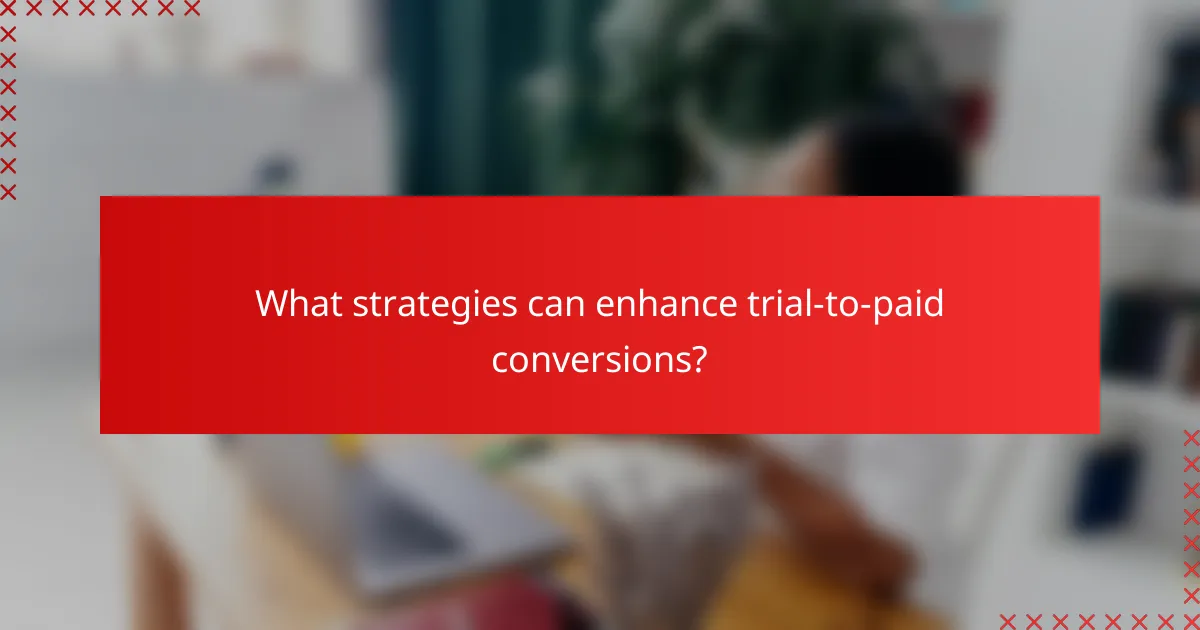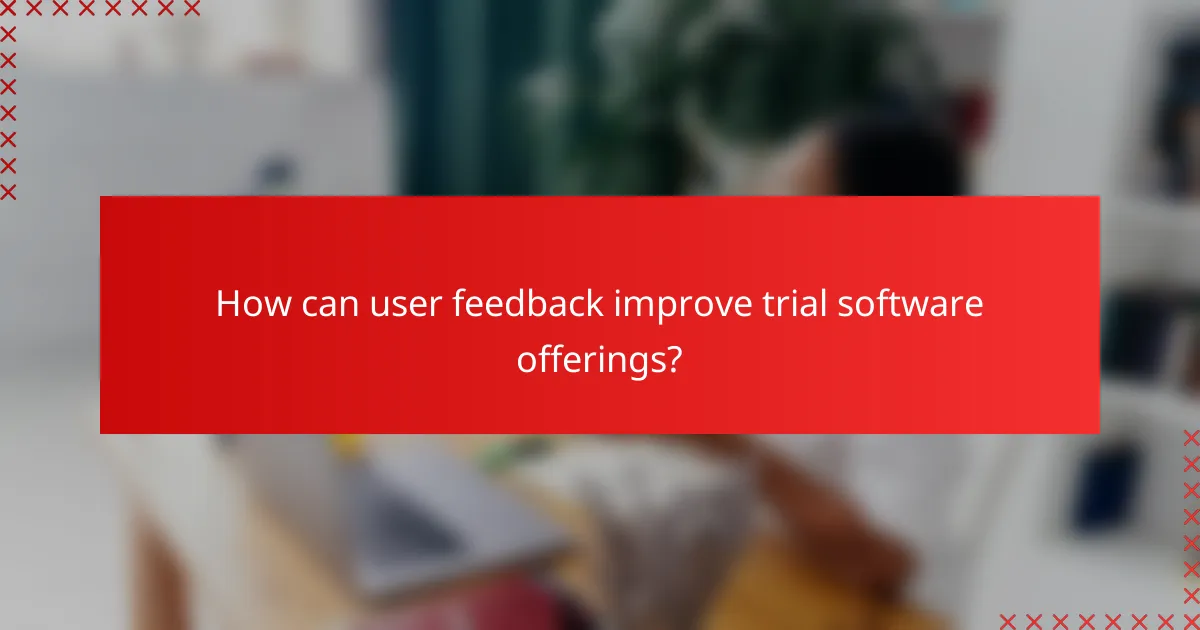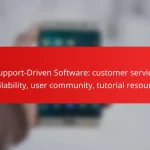Trial-based software options offer users a limited-time opportunity to explore various tools, enabling them to assess features before making a financial commitment. These trials typically come with restrictions on functionality and duration, which are crucial for users to understand. By allowing potential customers to experience a product risk-free, trial periods can significantly boost conversion rates and foster trust, ultimately leading to increased purchases.

What are trial-based software options available in the US?
Trial-based software options in the US provide users with limited-time access to various tools, allowing them to evaluate features before committing to a purchase. These trials often come with restrictions on functionality or duration, making it essential to understand the specifics of each offering.
Salesforce Free Trial
Salesforce offers a 30-day free trial that allows users to explore its comprehensive CRM features. During this trial, users can access core functionalities, including lead management, reporting, and automation tools, but may encounter limitations on the number of users or records.
To maximize the trial experience, focus on setting up your sales pipeline and testing the reporting features. Be aware that after the trial ends, you will need to choose a subscription plan, which can range from low hundreds to thousands of dollars annually, depending on the features selected.
HubSpot CRM Free Tier
HubSpot provides a free tier of its CRM that includes basic features suitable for small businesses. Users can manage contacts, track deals, and utilize email marketing tools without any time limit, making it a great option for startups looking to grow.
While the free tier is robust, advanced features such as automation and reporting require a paid upgrade. It’s advisable to evaluate your needs early on to determine if the free tier will suffice or if investing in a paid plan is necessary as your business scales.
Zoho CRM Free Trial
Zoho CRM offers a 15-day free trial that grants access to its full suite of features, including sales automation, analytics, and customer support tools. This trial is designed for up to three users, making it ideal for small teams testing the software’s capabilities.
During the trial, focus on customizing the dashboard and exploring the integration options with other Zoho applications. After the trial, subscription plans start at a modest monthly fee, allowing for scalability as your business grows. Be mindful of the features you find most useful to ensure you select the right plan post-trial.

How do trial periods impact user conversion rates?
Trial periods significantly influence user conversion rates by providing potential customers with a risk-free opportunity to experience a product. This exposure can lead to increased trust and familiarity, ultimately encouraging users to commit to a purchase.
Increased Engagement
Offering a trial period can enhance user engagement by allowing customers to explore features without immediate financial commitment. Users are more likely to interact with the software, leading to a deeper understanding of its benefits.
For instance, a software tool that offers a 14-day trial may see users spending more time on the platform, experimenting with various functionalities. This hands-on experience often results in users forming a habit around the product, making them more likely to convert.
Higher Conversion Potential
Trial periods can lead to higher conversion potential by addressing common objections users may have about purchasing. When users can test a product’s capabilities, they are more likely to feel confident in their decision to buy.
For example, if a user finds that a software solution effectively solves their problem during a trial, they are more inclined to subscribe. Businesses should consider follow-up strategies, such as offering discounts or personalized support, to capitalize on this heightened interest and drive conversions.

What are common feature restrictions in trial software?
Trial software often imposes feature restrictions to encourage users to upgrade to a paid version. These limitations can include user account caps, access to advanced functionalities, and time constraints on usage.
Limited User Accounts
Many trial versions restrict the number of user accounts that can be created or accessed. This means that teams may not be able to fully evaluate the software’s collaborative features, which can hinder their decision-making process.
For example, a trial might allow only one or two user accounts, making it difficult for larger teams to test the software’s capabilities. Consider whether the limited user accounts will provide a realistic view of how the software functions in your organization.
Restricted Access to Advanced Features
Trial software frequently limits access to advanced features that are essential for comprehensive evaluation. Users may find that critical tools, integrations, or customization options are only available in the paid version.
For instance, a project management tool might allow basic task tracking but restrict access to advanced reporting or automation features. When assessing trial software, identify which features are restricted and determine if they are vital for your needs.

What strategies can enhance trial-to-paid conversions?
Enhancing trial-to-paid conversions involves implementing targeted strategies that engage users and demonstrate the value of your software. Key approaches include personalized onboarding and follow-up email campaigns that nurture leads and address user needs.
Personalized Onboarding
Personalized onboarding tailors the initial user experience to individual preferences and needs, significantly improving engagement. By guiding users through key features relevant to their goals, you can help them realize the software’s value quickly.
Consider using interactive tutorials or personalized checklists that adapt based on user behavior. For instance, if a user frequently accesses a specific feature, highlight advanced functionalities related to that feature to deepen their understanding and usage.
Follow-Up Email Campaigns
Follow-up email campaigns are essential for maintaining engagement after the trial period begins. Sending targeted emails that provide tips, resources, and reminders can keep users interested and encourage them to convert to a paid plan.
Segment your email list based on user activity and preferences to deliver relevant content. For example, if a user hasn’t logged in for a week, send a re-engagement email with a special offer or a reminder of the software’s benefits. Aim for a series of 3-5 emails during the trial to maximize impact.

How can user feedback improve trial software offerings?
User feedback is essential for enhancing trial software offerings by identifying user needs and preferences. By actively collecting and analyzing feedback, companies can refine features, improve user experience, and increase conversion rates from trial to paid subscriptions.
Feature Prioritization
Gathering user feedback allows developers to prioritize features that matter most to their audience. For instance, if users consistently request specific functionalities, these should be prioritized in future updates. This approach ensures that the software evolves in line with user expectations, which can lead to higher satisfaction and retention rates.
Consider using surveys or feedback forms during the trial period to gauge which features users find most valuable. Focus on implementing a few high-impact features rather than trying to address every suggestion, as this can dilute resources and hinder overall product quality.
User Experience Enhancements
User feedback can significantly enhance the overall experience of trial software. By understanding pain points, developers can streamline onboarding processes, simplify navigation, and improve the overall interface. For example, if users report difficulty in finding certain tools, a redesign of the navigation menu may be warranted.
Implementing A/B testing based on user feedback can also help in optimizing user experience. By comparing different versions of the software, developers can determine which layout or feature set resonates more with users, leading to a more intuitive product that encourages trial users to convert to paying customers.

What metrics should be tracked during trial periods?
During trial periods, it’s essential to track metrics that indicate user engagement and retention. Key metrics like activation rate and churn rate provide insights into how effectively users are adopting the software and whether they are likely to continue using it after the trial ends.
Activation Rate
Activation rate measures the percentage of users who complete key actions that demonstrate engagement with the software. This could include tasks such as setting up their profile, completing a tutorial, or using a specific feature within a defined timeframe.
To calculate the activation rate, divide the number of users who achieve these milestones by the total number of trial users. A typical activation rate might range from 20% to 60%, depending on the software complexity and user onboarding processes.
To improve activation rates, focus on simplifying the onboarding experience and providing clear guidance through tutorials or tooltips. Avoid overwhelming new users with too many features at once.
Churn Rate
Churn rate indicates the percentage of users who discontinue using the software during the trial period. A high churn rate can signal issues with user experience, feature relevance, or perceived value.
To calculate churn rate, divide the number of users who drop out by the total number of trial users, typically expressed as a percentage. Churn rates can vary widely, but keeping it below 10% is generally considered a good target.
To reduce churn, regularly solicit user feedback to identify pain points and address them promptly. Offering personalized support or follow-up communications can also help retain users who may be on the verge of leaving.

What are the best practices for trial software marketing?
Effective trial software marketing focuses on attracting the right audience, showcasing key features, and converting users into paying customers. Implementing targeted advertising and robust content marketing strategies can significantly enhance trial engagement and conversion rates.
Targeted Advertising
Targeted advertising involves directing promotional efforts towards specific demographics or user segments likely to benefit from your software. Utilize platforms like Google Ads or social media to create campaigns that resonate with your ideal customers based on their interests, behaviors, and needs.
Consider using A/B testing to refine your ads and identify which messages or visuals perform best. This approach can help optimize your ad spend and improve conversion rates, ensuring that your marketing budget is used effectively.
Content Marketing Strategies
Content marketing strategies should focus on providing valuable information that addresses potential users’ pain points. Create blog posts, tutorials, and webinars that demonstrate how your software solves specific problems, thereby building trust and authority in your niche.
Incorporate calls-to-action (CTAs) within your content to encourage trial sign-ups. For instance, offering downloadable resources in exchange for email addresses can help grow your audience while promoting your trial software effectively.

How do trial-based software models compare internationally?
Trial-based software models vary significantly across countries, influenced by local regulations, consumer behavior, and market trends. Understanding these differences is crucial for businesses looking to implement effective trial strategies globally.
Limited-time access
Limited-time access is a common feature of trial-based software, allowing users to evaluate a product for a set duration, typically ranging from a week to a month. In regions like North America and Europe, offering a 14 to 30-day trial is standard, while some Asian markets may prefer shorter trials, around 7 to 14 days, to encourage quicker decision-making.
Companies should consider local preferences when determining trial lengths. For instance, in the U.S., longer trials may lead to higher conversion rates, while in Japan, a shorter trial might align better with consumer expectations.
Feature restrictions
Feature restrictions during trials help software companies manage costs and encourage users to upgrade. Common practices include limiting access to advanced features or capping usage levels. In Europe, for example, many SaaS companies restrict features to drive users toward premium plans, while in emerging markets, offering full access for a limited time can help build trust.
When implementing feature restrictions, clarity is essential. Clearly communicate what features are available during the trial to avoid user frustration and ensure a positive experience.
Conversion strategies
Effective conversion strategies are vital for turning trial users into paying customers. Common tactics include follow-up emails, offering discounts for early conversion, and providing personalized onboarding sessions. In North America, a typical strategy might involve a 20% discount if users convert within a week of the trial ending.
Businesses should analyze user behavior during the trial to tailor their conversion efforts. For instance, if users frequently engage with specific features, highlighting those in follow-up communications can increase the likelihood of conversion.







